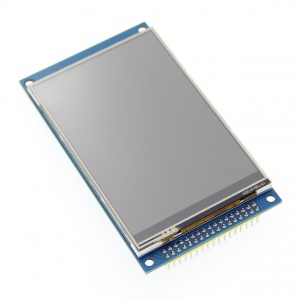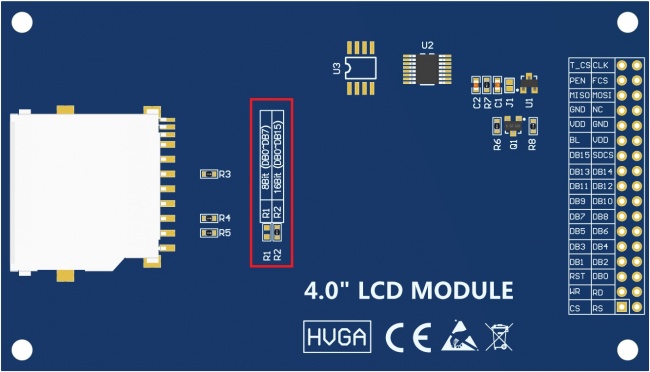More actions
| (8 intermediate revisions by 2 users not shown) | |||
| Line 5: | Line 5: | ||
en=http://www.lcdwiki.com/4.0inch_8&16BIT_Module_ST7796S_SKU:MRB3951 | en=http://www.lcdwiki.com/4.0inch_8&16BIT_Module_ST7796S_SKU:MRB3951 | ||
}} | }} | ||
== <font color="blue">Product Picture</font> == | == <font color="blue">Product Picture</font> == | ||
[[File:MRB3951- | [[File:MRB3951-001.jpg|300px]] | ||
==<font color="blue">Product Description</font> == | ==<font color="blue">Product Description</font> == | ||
| Line 57: | Line 54: | ||
|- | |- | ||
| align="center" |Operating Temperature | | align="center" |Operating Temperature | ||
| align="center" | - | | align="center" | -20℃~60℃ | ||
|- | |- | ||
| align="center" |Storage Temperature | | align="center" |Storage Temperature | ||
| align="center" | - | | align="center" | -30℃~70℃ | ||
|- | |- | ||
| align="center" |Operating Voltage | | align="center" |Operating Voltage | ||
| Line 68: | Line 65: | ||
| align="center" |TBD | | align="center" |TBD | ||
|- | |- | ||
| align="center" | | | align="center" |Rough Weight(Package containing) | ||
| align="center" | | | align="center" |68 (g) | ||
|} | |} | ||
==<font color="blue">Interface Definition</font> == | ==<font color="blue">Interface Definition</font> == | ||
''' | [[File:MRB3951-005.jpg|650px]] | ||
The red box in the above figure is the 8-bit/16-bit data bus mode switch, which is described as follows: | |||
:Solder '''R2''' with 0Ω resistor or short circuit directly, and disconnect '''R1''': Select '''16'''-bit data bus mode (default),use '''DB0~DB15''' data pin | |||
:Solder '''R1''' with 0Ω resistor or short circuit directly, and disconnect '''R2''': Select '''8'''-bit data bus mode use '''DB0~DB7''' data pin | |||
{| class="wikitable" border="1" style="width: 650px; background-color: white;" | {| class="wikitable" border="1" style="width: 650px; background-color: white;" | ||
| align="center" |Number | | align="center" |Number | ||
| Line 202: | Line 203: | ||
|- | |- | ||
|} | |} | ||
==<font color="blue">How to use on STM32 development board</font> == | ==<font color="blue">How to use on STM32 development board</font> == | ||
| Line 236: | Line 215: | ||
*'''Step 2: Connect the STM32 development board''' | *'''Step 2: Connect the STM32 development board''' | ||
# Find the TFTLCD Slot on the development board, connect the module pins and Slot(For example, the module CS pin corresponds to the slot CS pin), and then plug them directly into the Slot | # Find the TFTLCD Slot on the development board, connect the module pins and Slot(For example, the module CS pin corresponds to the slot CS pin), | ||
::and then plug them directly into the Slot | |||
*'''Step 3: Compile and download the program to the development board''' | *'''Step 3: Compile and download the program to the development board''' | ||
| Line 245: | Line 226: | ||
# After the program is finished, observe the running status of the program. If it can be displayed normally, the program runs successfully. | # After the program is finished, observe the running status of the program. If it can be displayed normally, the program runs successfully. | ||
==<font color="blue">Program Download</font> == | |||
* [http://www.lcdwiki.com/res/Program/Parallel_Port/4.0inch/8_16BIT_ST7796S_MRB3951_V1.0/4.0inch_8&16BIT_Module_ST7796S_MRB3951_V1.0.zip '''4.0inch 16bit Parallel-Port Module package'''] | |||
==<font color="blue">Product Documentation</font> == | |||
* [http://www.lcdwiki.com/res/MRB3951/4.0inch_8&16BIT_Module_MRB3951_User_Manual_EN.pdf '''4.0inch 16bit Parallel-Port Module User Manual'''] | |||
* [http://www.lcdwiki.com/res/MRB3951/QD-40037C1-00_specification_V1.0.pdf '''4.0inch TFTLCD Specification'''] | |||
* [http://www.lcdwiki.com/res/MRB3951/4.0inch_MRB3951_Size.pdf '''4.0inch 16bit Parallel-Port Module Size Picture(pdf Version)'''] | |||
* [http://www.lcdwiki.com/images/7/7f/MRB3951-006.jpg '''4.0inch 16bit Parallel-Port Module Size Picture(jpg Version)'''] | |||
* [http://www.lcdwiki.com/res/MRB3951/4.0inch_MRB3951_Schematic_V1.0.pdf '''4.0inch 16bit Parallel-Port Module Schematic'''] | |||
* [http://www.lcdwiki.com/res/MRB3951/Altium_Package_library.zip '''4.0inch 16bit Parallel-Port Module LCD Schematic and PCB Package Library'''] | |||
* [http://www.lcdwiki.com/res/MRB3951/ST7796S-Sitronix.pdf '''Driver IC ST7796S Data sheet'''] | |||
==<font color="blue">Reference Materials</font> == | |||
* [http://www.lcdwiki.com/res/PublicFile/C51_Keil%26stc-isp_Use_Illustration_EN.pdf '''C51 Keil and stc-isp software use illustration'''] | |||
* [http://www.lcdwiki.com/res/PublicFile/STM32_Keil_Use_Illustration_EN.pdf '''STM32 keil software use illustration'''] | |||
* [http://www.lcdwiki.com/res/PublicFile/PCtoLCD2002_Use_Illustration_EN.pdf '''PCtoLCD2002 software use illustration'''] | |||
* [http://www.lcdwiki.com/res/PublicFile/Image2Lcd_Use_Illustration_EN.pdf '''Image2Lcd software use illustration'''] | |||
* [http://www.lcdwiki.com/Chinese_and_English_display_modulo_settings '''Chinese and English display modulo settings'''] | |||
==<font color="blue">Common Software</font> == | ==<font color="blue">Common Software</font> == | ||
Latest revision as of 10:29, 28 September 2019
Product Picture
Product Description
- 4.0-inch color screen, support 16BIT RGB 65K color display, display rich colors
- 320x480 resolution for clear display
- Supports 8-bit and 16-bit parallel bus transmission with fast transfer speed
- Supports ALIENTEK STM32 Mini, Elite, WarShip, Explorer, and Apollo development boards TFTLCD for direct plug-in use
- Support for touch function
- Support SD card function expansion
- Provides a rich sample program for STM32 and C51 platforms
- Military-grade process standards, long-term stable work
- Provide underlying driver technical support
Product Parameters
| Name | Parameter |
| Display Color | 16BIT RGB 65K color |
| SKU | MRB3951 |
| Screen Size | 4.0(inch) |
| Type | TFT |
| Driver IC | ST7796S |
| Resolution | 480*320 (Pixel) |
| Module Interface | 8bit or 16Bit parallel interface |
| Active Area | 83.52x55.68(mm) |
| Module PCB Size | 61.98x108.80 (mm) |
| Operating Temperature | -20℃~60℃ |
| Storage Temperature | -30℃~70℃ |
| Operating Voltage | 3.3V~5V |
| Power Consumption | TBD |
| Rough Weight(Package containing) | 68 (g) |
Interface Definition
The red box in the above figure is the 8-bit/16-bit data bus mode switch, which is described as follows:
- Solder R2 with 0Ω resistor or short circuit directly, and disconnect R1: Select 16-bit data bus mode (default),use DB0~DB15 data pin
- Solder R1 with 0Ω resistor or short circuit directly, and disconnect R2: Select 8-bit data bus mode use DB0~DB7 data pin
| Number | Pin Label | Description |
| 1 | CS | LCD reset control pin( low level enable) |
| 2 | RS | LCD register / data selection control pin(high level: register, low level: data) |
| 3 | WR | LCD write control pin |
| 4 | RD | LCD read control pin |
| 5 | RST | LCD reset control pin( low level reset) |
| 6 | DB0 | LCD data bus low 8-bit pin |
| 7 | DB1 | |
| 8 | DB2 | |
| 9 | DB3 | |
| 10 | DB4 | |
| 11 | DB5 | |
| 12 | DB6 | |
| 13 | DB7 | |
| 14 | DB8 | LCD data bus high 8-bit pin (not used in 8-bit data bus mode) |
| 15 | DB9 | |
| 16 | DB10 | |
| 17 | DB11 | |
| 18 | DB12 | |
| 19 | DB13 | |
| 20 | DB14 | |
| 21 | DB15 | |
| 22 | SDCS | SD card selection control pin (used when using the SD card expansion function, this test program is not used) |
| 23 | BL | LCD backlight control pin(High level light) |
| 24 | VDD | Module power positive pin (module has integrated voltage regulator IC, so the power supply can be connected to 5V or 3.3V) |
| 25 | VDD | |
| 26 | GND | Module power ground pin |
| 27 | GND | |
| 28 | NC | LCD backlight power positive pin (default shared onboard backlight power supply, this pin can not be connected) |
| 29 | MISO | Touch screen SPI bus data input pin |
| 30 | MOSI | Touch screen SPI bus data output pin |
| 31 | PEN | Touch screen interrupt detection pin(Low level when a touch occurs) |
| 32 | FCS | Flash chip select control pin (used when using the Flash extension function, this test program is not used) |
| 33 | T_CS | Touch screen IC chip select control pin(Low level enable) |
| 34 | CLK | Touch screen SPI bus clock control pin |
How to use on STM32 development board
This module is compatible with the ALIENTEK STM32 development board. The specific usage is as follows:
- Step 1: Download the test program
- Download the STM32 test program from the Program Download column
- For a description of the relevant test procedures, please refer to the test program documentation in the package
- Step 2: Connect the STM32 development board
- Find the TFTLCD Slot on the development board, connect the module pins and Slot(For example, the module CS pin corresponds to the slot CS pin),
- and then plug them directly into the Slot
- Step 3: Compile and download the program to the development board
- Compile and download the program you need to test to the STM32 development board( Don't know how to compile and download?)
- Step 4: Observe the running of the program
- After the program is finished, observe the running status of the program. If it can be displayed normally, the program runs successfully.
Program Download
Product Documentation
- 4.0inch 16bit Parallel-Port Module User Manual
- 4.0inch TFTLCD Specification
- 4.0inch 16bit Parallel-Port Module Size Picture(pdf Version)
- 4.0inch 16bit Parallel-Port Module Size Picture(jpg Version)
- 4.0inch 16bit Parallel-Port Module Schematic
- 4.0inch 16bit Parallel-Port Module LCD Schematic and PCB Package Library
- Driver IC ST7796S Data sheet
Reference Materials
- C51 Keil and stc-isp software use illustration
- STM32 keil software use illustration
- PCtoLCD2002 software use illustration
- Image2Lcd software use illustration
- Chinese and English display modulo settings


